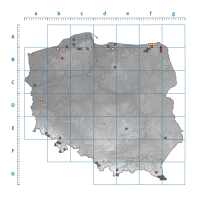. Introduction
Parmelia submontana Nádv. ex Hale is one of nine species of the Parmelia genus found in Poland (Fałtynowicz et al., 2024; Ossowska, 2021). It is one of the rarest and of greatest interest species in the genus in the country, as evidenced by various publications dedicated to this taxon (e.g. Fałtynowicz, 1993; Kubiak, 2000; Motiejūnaitė et al., 2003). Lichenologists all over Europe have also paid special attention to this lichen due to its rarity (e.g., Arvidsson, 1989; Christensen, 1997; Degelius, 1935; Gauslaa, 1999; Schindler, 1997; Thell et al., 2017). In Poland, P. submontana is under strict legal protection (Regulation…, 2014) and is listed as a species of Vulnerable (VU category) on the “Red List…” (Cieśliński et al., 2006).
Wigry National Park, where half of the described in this paper P. submontana localities were found, has been extensively explored by lichenologists (Bystrek & Matwiejuk, 1994, 1999; Bystrek & Przepiórkowska, 1994; Fałtynowicz, 1994; Fałtynowicz & Krzysztofiak, 2010; Matwiejuk, 2010). Despite this, new lichen species continue to be discovered in the area. The region is considered one of the most intriguing lichenological regions in the Central European lowlands. Recent research conducted after 2010 has led to a significant increase in the number of species identified in the area; more than 300 lichen species have been documented in the park (see Fałtynowicz et al., 2017; Fałtynowicz & Halama, 2013).
The aim of this study was to contribute to the current understanding of the distribution of the rare lichen species Parmelia submontana in Poland.
. Material and methods
New localities were found in the years 2003–2018 during the implementation of various research and monitoring projects.
The distribution map of the sites studied was based on the ATPOL grid (Cieśliński & Fałtynowicz, 1993). Information on the worldwide and Polish distribution of the Parmelia submontana was collected from the literature. Herbarium specimens were collected only from the Wigry National Park and the Góry Stołowe Mts and deposited in the WRSL.
. Results and discussion
Distribution of P. submontana in the world
P. submontana is classified as a sub-Atlantic species but is most abundant in the mountains of the Mediterranean zone (cf. Degelius, 1935; Nimis, 2016). According to Hale (1987), it is representative of the southern Mediterranean European mountain element. Regardless of these classifications, the range of P. submontana is wide. It is found throughout Europe, from the Urals and Caucasus in Russia (Urbanavichius, 2010) to Portugal (Jones, 2002) and from the Scandinavian Peninsula (Santesson, 1993) to North Africa (Schindler, 1997). In northern and central Europe, it has few and dispersed localities, although Thell et al. (2017) state that this species has clearly spread in Scandinavia in recent years.
Outside Poland, it has been found in single sites in Królewiec Region (Russia) (Zalewska et al., 2004), Lithuania (Motiejūnaitė, 2015, 2017), Latvia (Motiejūnaitė et al., 2016), Estonia (Randlane et al., 2014), Ukraine (Kondratyuk et al., 1998), Slovakia (e.g., Lisická, 2005), Czech Republic (Liška et al., 2008), and Hungary (Papp et al., 2020). It has slightly more sites in Germany (Scholz, 2000), Austria (Hafellner & Türk, 2016), southern France (Roux, 2012), and Italy, especially in the Apennines (Nimis, 2016), but also in Sardinia (Vězda, 1988). P. submontana is also known from Romania (Vicol, 2016), Greece (Arcadia, 2022), Spain (Aragón & Rico, 1997; Blázquez, 2022), Turkey (Karagünlü & Tufan-Çetin, 2020), Portugal (Paz-Bermúdez et al., 2009), the UK (Smith et al., 2009), Belgium, and Luxembourg (Sérusiaux et al., 2004), Denmark (Christensen, 1997), as well as Sweden and Norway (Thell et al., 2017). The southernmost localities of this species have been found in Tenerife in the Canary Islands (Hawksworth et al., 2008), Tunisia (Seaward, 1996), and the Atlas Mountains of northern Morocco (Molina et al., 2011; Ravera, 2001; Schindler, 1997).
Parmelia submontana Nádv. ex Hale
The specimens of P. submontana found were typically formed at most localities. Only at locality 2 in Wigry National Park and at the locality in Zaboryszki were the lobes short (ca. 2 cm) and partially covered with algae. This may indicate a weakened condition of the thalluses. At none of the new sites were apothecia found.
New localities and distribution of P. submontana in Poland
P. submontana was discovered in four separate locations within Wigry National Park, spanning two ATPOL squares, as indicated in Figure 1. The locations and details are as follows:
Figure 1
Distribution of Parmelia submontana localities in Poland on the background of the grid lines ATPOL.
Explanations: ∙ – localities according to Ossowska (2021); □ – localities known after 2021; △ – new localities.

1/54,06326 N; 23,02877 E; found on a branch in the crown of Populus tremula at a height of approximately 18 m; 26.09.2016;
2/54.1034 N; 23.03135 E; found on a trunk of Quercus robur at a height of approximately 10 m; 01.09.2016;
3/54.10911 N; 23.057528 E; found on a branch in the crown of Populus tremula at a height of approximately 16 m; 01.09.2018;
4/53.99412 N; 23.17372 E; forest section 330/331/348/349, found on a trunk of Quercus robur at a height of 2 m, 26.09.2016.
In three locations, P. submontana grew high up in strongly illuminated tree crowns, and only at the height of 2 m low on the trunk, but also in an exposed area, as the tree is located at a forest road intersection. The species populations were scarce, but all specimens had typically developed thalli.
Apart from Wigry National Park, we found new localities of P. submontana in four other places in the country (Figure 1):
1/54.23878 N; 23.09901 E; Zaboryszki village near Szypliszki, on the trunk of Salix fragilis at a height of approximately 1,5 m growing over the drainage ditch near the forester’s lodge, several thallus; 07.1999;
2/53.7786 N; 16.4941 E; Storkowo village near Szczecinek, near the Geoecological Station of the Adam Mickiewicz University; very rich population on the trunk of Carpinus betulus at a height of 1–2 m in the oak-hornbeam forest, next to the Młyński Potok River (a small tributary of the Parsęta River); 07.2003;
3/50.3776 N; 16.2893 E; Góry Bystrzyckie Mts, Taszów village, by the village road; very rich population on the trunk of Acer platanoides at 1–2 m; 08.2017;
4/50,6556 N; 16,4408 E; Góry Stołowe Mts, near Studzienna village, red hiking trail, on the trunk of Acer platanoides; 09.2007 at 1–2 m.
Ossowska (2021) reports 68 sites of P. submontana in Poland, located in 33 squares of the ATPOL grid. In addition, other authors (Kossowska et al., 2022; Kukwa et al., 2020; Zalewska et al., 2004) report this species from ten more sites, and new data from six ATPOL squares are presented in this article. Most sites are located in the north of Poland, within the belt of moraines from the last glaciation. Many sites have been found in mountainous regions, while only a few are scattered in the highlands of the central part of the country (refer to Figure 1). P. submontana grows most often on the following trees: Acer (24% of all sites), Quercus (15.5%), Carpinus (14%), Populus (8.5%), and Tilia (8.5%). It has occasionally been found on Abies, Alnus, Betula, Fagus, Fraxinus, Malus, Padus, Picea, Robinia, Salix, Sorbus, and on bedrock. It thrives in various habitat conditions, but in most cases, it prefers good access to light and places with significant air humidity, often growing near watercourses or lakes. It has been observed on roadside trees or high up in the tree crowns.
P. submontana is likely more common in Poland than previously believed, as it is often mistaken for other lichen taxa due to its high similarity. Furthermore, its tendency to grow high on tree trunks and in their crowns may contribute to its underestimation. On a national scale, the species does not appear to be endangered; Kościelniak (2006) reported that P. submontana is spreading intensively in southeastern Poland.


